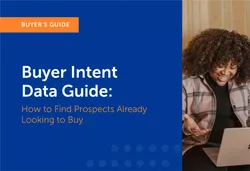In the dynamic realm of B2B sales and marketing, data reigns supreme. However, the mere accumulation of data points is insufficient. Savvy marketers and astute sales professionals understand that the true power lies in deciphering the signals within that data, particularly the potent insights offered by B2B intent data. A profound understanding of customer needs, fortified by data intelligence, transcends a mere competitive advantage; it lays the foundation for a robust and consistent pipeline, primed for the sales team to convert.
Yet, the mastery of leveraging data for profound customer insights remains a relatively untapped skill among many marketers and sales professionals. Within the vast ocean of customer information, intent data emerges as a critical beacon, illuminating the path towards more effective sales and marketing strategies.
What is Intent Data?
In its simplest form, intent data comprises the array of behavioral signals that provide a window into a prospect’s genuine inclination to purchase a specific product or service. Think of it as the digital breadcrumbs your potential customers leave behind as they navigate the online landscape in search of solutions to their business challenges.
Your prospects are actively engaged in a quest to resolve their pain points, and their journey often begins online. They conduct searches, consume relevant content, explore potential solutions, and seek knowledge that will alleviate their business pressures.
Compelling studies reveal that, on average, a B2B prospect is already a significant 67% through their purchasing journey before they even engage with a salesperson. By strategically combining these overt prospect signals with the more nuanced insights gleaned from buyer intent data, businesses gain a comprehensive, bird’s-eye view.
This holistic perspective empowers them to leverage customer intelligence to their distinct advantage. Essentially, intent data helps identify those prospects who harbor a genuine intention to buy, allowing sales representatives to focus their efforts on the crucial remaining 33% of the journey – closing the deal.
Consider the initial touchpoints. Once prospective buyers land on your website, their activity becomes a direct signal. You can meticulously monitor their engagement, assigning lead scores based on their interactions. Retargeting advertising campaigns and personalized email sequences can then be deployed to nurture these leads, particularly when a prospect actively engages by filling out and submitting a form on your site.
However, a critical question arises: what about the vast pool of prospects who are actively seeking solutions akin to yours elsewhere on the internet, beyond the confines of your own digital domain? When your potential customers visit competitor websites, industry publications, and relevant forums, you often lack visibility into their engagement.
The reality is that only a fraction of buyers actively searching for a solution will organically find their way to your website without proactive sales and marketing outreach. Furthermore, even among those who do visit your site, only a small percentage – approximately 15% – will be actively involved in a current buying decision.
This is precisely where the power of buyer intent data truly shines. It enables you to identify those elusive prospects who are actively engaged in a buying decision based on the specific types of content they are consuming across the web. Solutions like SalesIntel provide access to this crucial layer of off-site intent data, enriching your understanding of prospect behavior.
What Types of Intent Data Are Out There?
The landscape of intent data is multifaceted, with various types of signals providing different levels of insight into a prospect’s buying journey. Understanding these nuances is crucial for effective utilization. Broadly, intent data can be categorized into the following:
First-Party Intent Data
This is the goldmine of information you collect directly from your own digital properties and customer interactions. It encompasses website activity (page views, content downloads, form submissions, product demos requested), engagement with your marketing materials (email opens, clicks), and interactions with your sales team. First-party intent data offers the most direct and contextually relevant insights into your existing and potential customers’ behavior.
Second-Party Intent Data
This involves data shared directly between two organizations with a mutual benefit. For instance, a partner company might share data about leads who have shown interest in complementary solutions. While not as directly controlled as first-party data, second-party data can provide valuable insights into adjacent markets and potential cross-selling opportunities.
Third-Party Intent Data
This vast pool of data is aggregated and sold by specialized vendors who track online behavior across a wide network of websites and digital touchpoints. Third-party intent data typically focuses on identifying companies researching specific topics or keywords relevant to your industry. This type of data can help you identify new prospects who might not yet be on your radar. Within third-party data, there are further distinctions:
Topic-Based Intent Data
This identifies organizations showing interest in specific topics or keywords related to your solutions. For example, if your company offers cybersecurity software, you might look for companies actively researching “ransomware protection” or “data breach prevention.” SalesIntel excels at providing granular topic-based intent data.
Account-Level Intent Data
This aggregates the online behavior of individuals within a specific target account to provide an overall intent score for that organization. This is particularly valuable for account-based marketing (ABM) strategies.
Contact-Level Intent Data
While less common due to privacy considerations, some third-party providers may offer insights into the intent signals of individual contacts within target organizations.
Technographic Intent Data
This focuses on the technologies a company currently uses or is actively researching. Understanding a prospect’s tech stack can reveal compatibility needs, potential integration opportunities, and their readiness to adopt new solutions. For example, knowing a company uses a specific CRM platform might make them a prime target for a complementary marketing automation tool. SalesIntel often combines intent data with robust technographic information for a holistic view.
Firmographic Intent Data
This layer of intent data considers the characteristics of a company, such as its size, industry, revenue, and location. While traditionally used for segmentation, when combined with behavioral intent signals, firmographic data can help prioritize outreach to ideal customer profiles exhibiting active buying interest. SalesIntel provides comprehensive firmographic data to refine your targeting.
What Are the Benefits of Intent Data?
The strategic implementation of intent data unlocks a multitude of benefits for B2B organizations, transforming their sales and marketing endeavors from reactive to proactive and significantly enhancing overall performance.
Identification of High-Potential Leads
At its core, intent data empowers you to pinpoint prospects who are actively in the market for solutions like yours. By tracking their online research and engagement, you can identify companies that are exhibiting strong buying signals, even if they haven’t yet directly interacted with your brand. This allows you to focus your resources on the most promising opportunities. SalesIntel’s intent data solutions are designed to surface these high-potential leads.
Prioritization of Leads
Not all leads are created equal. Intent data helps you differentiate between casual researchers and those with a genuine and urgent need. By understanding where prospects are in their buying journey based on their online behavior, you can prioritize outreach to those further along the funnel, increasing the likelihood of conversion and optimizing your sales team’s time.
Enablement of Personalized Outreach
Generic marketing messages often fall flat in today’s information-saturated environment. Intent data provides invaluable context that enables highly personalized communication. For instance, if a prospect is frequently consuming content about a specific feature of your product or attending webinars on a related topic, your sales and marketing teams can tailor their messaging to directly address those specific needs and interests, making your outreach far more relevant and impactful. SalesIntel equips you with the insights needed for this level of personalization.
Transformation of Business Approach
Intent data facilitates a fundamental shift from reactive to proactive strategies. Instead of waiting for leads to come to you, you can actively identify and engage with companies that are already demonstrating a need for your solutions. This proactive approach allows you to get ahead of the competition and position yourself as a valuable resource early in the buyer’s journey.
Improved Overall Performance
The cumulative effect of these benefits translates into tangible improvements in key performance indicators (KPIs). Organizations leveraging intent data typically experience higher conversion rates as they focus on qualified prospects, more efficient use of their marketing budgets by targeting those with demonstrated interest, and shorter sales cycles by engaging prospects who are already actively researching solutions. SalesIntel customers often report significant improvements in these areas.
Intent data acts as a key to unlocking valuable insights into the evolving needs and priorities of your target audience. By analyzing the topics and keywords they are researching, you can gain a deeper understanding of their pain points and tailor your offerings and messaging accordingly.
Staying Ahead of the Competition
In today’s competitive landscape, understanding your prospects’ intentions can provide a significant edge. By identifying potential customers early in their research process, you can position your company as the preferred solution before your competitors even engage.
How to Drive Sales and Marketing with Intent Data
The true power of intent data lies in its practical application across various sales and marketing functions. Here’s how you can effectively leverage these insights to drive tangible results:
Account-Based Marketing (ABM)
Intent data is a cornerstone of successful ABM strategies. By identifying high-value target accounts exhibiting strong intent signals related to your solutions, you can create highly personalized and targeted marketing campaigns designed to resonate with their specific needs and pain points. This ensures that your ABM efforts are focused on the accounts most likely to convert. SalesIntel’s account-level intent data is invaluable for ABM initiatives.
Lead Prioritization and Scoring
Implement intent data into your lead scoring models to identify and prioritize the hottest leads. Prospects demonstrating high levels of intent activity should be routed to your sales team promptly, increasing the chances of timely engagement and conversion. SalesIntel provides the data needed to build robust intent-driven scoring models.
Personalized Content Marketing
Use intent data to inform your content creation strategy. By understanding the topics your target audience is actively researching, you can develop relevant and valuable content that addresses their specific questions and challenges, positioning your brand as a trusted authority and attracting engaged prospects.
Targeted Advertising
Enhance the effectiveness of your advertising campaigns by targeting prospects who are showing intent for relevant keywords and topics. This ensures that your ad spend is focused on reaching individuals and organizations actively seeking solutions you provide, leading to higher click-through rates and conversion rates.
Sales Enablement
Equip your sales team with intent insights to provide them with a deeper understanding of their prospects’ needs and interests before they even have their first interaction. This enables them to tailor their sales pitches and presentations for maximum impact, addressing specific pain points and demonstrating a clear understanding of the prospect’s business challenges. SalesIntel provides sales teams with actionable intent intelligence.
Trigger-Based Marketing Automation
Integrate intent data with your marketing automation platform to trigger personalized email sequences and other marketing activities based on specific intent signals. For example, if a prospect downloads a whitepaper on a particular topic, you can automatically send them a follow-up email with related case studies or product information.
Competitive Intelligence
Monitor intent data related to your competitors to gain insights into market trends and identify potential opportunities for differentiation. Understanding what your competitors’ target audience is researching can help you refine your messaging and positioning.
How to Use Intent Data: Practical Implementation Strategies
Effectively leveraging intent data requires a strategic approach and the right tools. Here’s a step-by-step guide to putting intent data into action:
1. Define Your Ideal Customer Profile (ICP)
Before diving into intent data, clearly define your ICP. Understanding the characteristics of your ideal customer will help you focus your intent data analysis on the most relevant signals.
2. Identify Relevant Intent Signals
Based on your ICP and solutions, determine the specific topics, keywords, and online behaviors that indicate buying intent for your products or services. SalesIntel can help you identify these key intent signals.
3. Choose the Right Intent Data Sources
Evaluate different intent data providers and sources based on your specific needs and budget. Consider the types of intent data they offer, their data accuracy, and their integration capabilities with your existing marketing and sales technology stack. SalesIntel is a leading provider known for its accuracy and comprehensive B2B data.
4. Integrate Intent Data with Your CRM and Marketing Automation Platforms
Seamless integration is crucial for operationalizing intent data. Connect your intent data sources with your CRM and marketing automation platforms to enrich your lead and account records with valuable intent insights. SalesIntel offers seamless integrations with popular platforms.
5. Develop Lead Scoring Models
Incorporate intent data into your lead scoring models. Assign higher scores to leads and accounts exhibiting strong intent signals, ensuring that your sales team prioritizes the most promising opportunities. SalesIntel’s data can significantly enhance your lead scoring accuracy.
6. Create Targeted Segments
Segment your audience based on their intent data. This allows you to create highly personalized marketing campaigns and tailor your messaging to the specific interests and needs of each segment.
7. Develop Personalized Content Strategies
Use intent data to inform your content creation efforts. Identify the topics your target audience is researching and create valuable content that addresses their pain points and provides solutions.
8. Train Your Sales and Marketing Teams
Ensure that your sales and marketing teams understand the value of intent data and how to leverage it effectively in their daily activities. Provide them with the necessary training and resources to interpret intent signals and personalize their interactions.
9. Monitor and Analyze Results
Continuously track the performance of your intent-driven sales and marketing initiatives. Analyze key metrics such as lead quality, conversion rates, and sales cycle length to identify what’s working and areas for improvement.
10. Iterate and Optimize
Based on your analysis, continuously refine your intent data strategy and tactics. The B2B landscape is constantly evolving, so it’s essential to stay agile and adapt your approach as needed.
Where to Get Intent Data: Exploring Data Sources and Providers
Accessing reliable and relevant intent data is paramount for successful implementation. Here are the primary sources and types of providers you can consider:
Third-Party Intent Data Providers
These specialized vendors aggregate and sell intent data collected from a vast network of websites and online interactions. Leading providers like SalesIntel are known for their comprehensive data coverage and accuracy. When choosing a provider, consider factors such as data accuracy, coverage, integration capabilities, pricing models, and the specific types of intent data offered.
Marketing Automation Platforms (MAPs) with Intent Data Capabilities
Some MAPs, such as HubSpot and Marketo, have integrated intent data features or offer integrations with third-party providers like SalesIntel. These platforms can help you manage and activate intent data within your existing marketing workflows.
CRM Platforms with Intent Data Integrations
Similarly, some CRM platforms, like Salesforce, offer integrations with intent data providers, allowing you to view intent signals directly within your lead and account records. SalesIntel offers robust CRM integrations.
Publisher Co-ops
As mentioned earlier, these are consortiums of publishers who pool their first-party data, offering insights into the content consumption of their audience. Participating in relevant publisher co-ops can provide valuable, albeit potentially limited in scope, intent data.
When selecting an intent data source, it’s crucial to thoroughly vet the provider’s data collection methods and ensure compliance with data privacy regulations such as GDPR and CCPA. Transparency and ethical data practices are paramount. SalesIntel is committed to ethical and compliant data practices.
While the benefits of intent data are significant, it’s essential to be aware of potential challenges and implement strategies to mitigate them:
Data Accuracy and Noise
The quality and accuracy of intent data can vary significantly between providers. It’s crucial to choose reputable sources like SalesIntel, known for its accurate B2B data, and implement data validation processes to minimize noise and ensure you’re acting on reliable information.
Integration Complexity
Integrating intent data with your existing marketing and sales technology stack can sometimes be complex, requiring technical expertise and careful planning. Ensure that your chosen providers, such as SalesIntel, offer robust integration capabilities and provide adequate support.
Interpretation and Actionability
Raw intent data alone is not enough. You need skilled analysts and clear processes to interpret the signals and translate them into actionable insights for your sales and marketing teams. SalesIntel often provides resources and support to help with this interpretation.
Cost Considerations
Intent data services can represent a significant investment. Carefully evaluate the pricing models of different providers and ensure that the potential ROI justifies the cost. The ROI achieved by SalesIntel customers often demonstrates its value.
Privacy Concerns and Compliance
As highlighted earlier, it’s crucial to be mindful of data privacy regulations and ensure that your intent data providers adhere to ethical and compliant data collection practices. Transparency with your own customers about data usage is also essential. SalesIntel prioritizes data privacy and compliance.
Over-Reliance on Intent Data
While powerful, intent data should not be the sole basis for your sales and marketing decisions. It’s most effective when combined with other data points, such as firmographic and technographic information – areas where SalesIntel provides significant value – to create a holistic view of your prospects.
Final Thoughts
In the competitive arena of B2B sales and marketing, understanding the genuine intentions of your potential customers is no longer a luxury – it’s a fundamental necessity for achieving sustainable growth and a significant competitive advantage. Intent data, especially when accessed through a reliable platform like SalesIntel, provides the crucial insights needed to move beyond guesswork and engage with prospects who are actively seeking solutions.
By strategically integrating intent data from sources like SalesIntel into your marketing and sales strategies, you can achieve more precise targeting, deliver truly personalized engagement, optimize your marketing spend, shorten your sales cycles, and ultimately drive higher conversion rates. The future of successful B2B marketing lies in the intelligent.
FAQs
What are the best intent data providers and tools available in the market?
Leading intent data providers help businesses identify in-market accounts by analyzing digital buying signals. Top solutions include SalesIntel, ZoomInfo, 6sense, Demandbase, and Lusha. Each helps uncover active prospects and prioritize outreach, but SalesIntel stands out with human-verified data and integrated intent insights for precision targeting and higher pipeline efficiency.
What are some examples of companies successfully using intent data?
Companies across industries use intent data to align sales and marketing efforts around real buying interest. For example, software firms identify accounts by researching competitors, while marketing agencies personalize ad campaigns to boost conversions. Many, like SalesIntel clients, achieve measurable revenue growth by using intent signals to engage buyers at the perfect moment in their journey.
What exactly is intent data?
Intent data captures behavioral signals that indicate a company’s readiness to purchase. These signals, such as searches, content engagement, and website visits, reveal what topics or solutions prospects are researching. SalesIntel transforms these insights into actionable intelligence, helping teams identify buying-ready accounts early and engage before competitors do.
How is intent data collected?
Intent data is gathered from multiple sources:
- First-party: Directly from your website and marketing interactions.
- Second-party: Shared between trusted partners.
- Third-party: Collected by vendors monitoring behavior across publisher networks.
SalesIntel combines these layers, providing verified, privacy-compliant intent data to pinpoint companies actively researching your solution category.
What are the different types of intent data?
Intent data spans several categories:
- First-party (your own user engagement data)
- Second-party (partner-shared insights)
- Third-party (aggregated behavioral data across sites)
Within third-party data, SalesIntel offers topic-based, account-level, and contact-level intent insights, along with technographic and firmographic layers, to help teams prioritize high-value prospects with precision.







